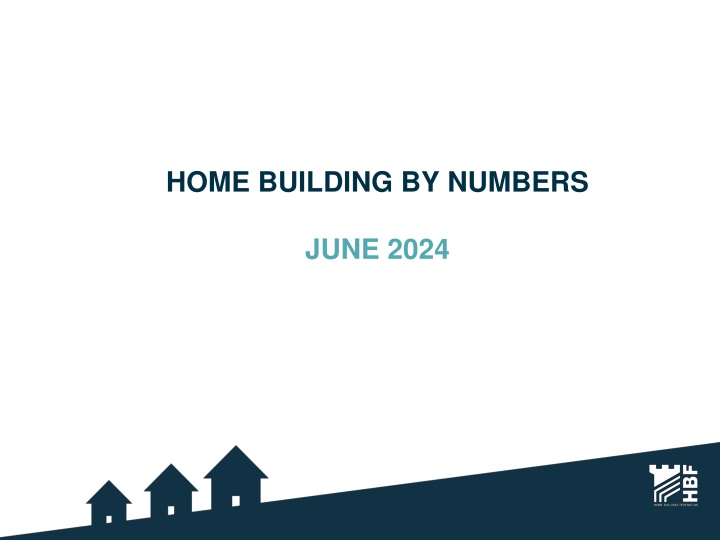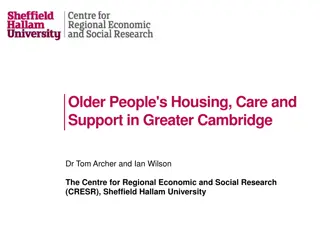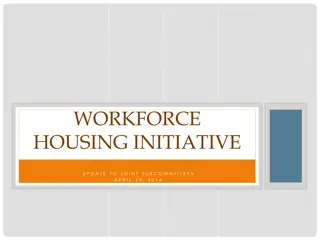Overview of Housing Supply and Economic Impact in the UK
England experienced a significant increase in housing supply in 2022/23, with new build completions and conversions contributing to a record-breaking net supply of 320,000 homes per year. Despite challenges in planning permissions and government interventions, the home building industry supported thousands of jobs and generated substantial economic activity. However, recent trends show a decline in planning permissions, signaling potential future challenges for housing supply.
Download Presentation

Please find below an Image/Link to download the presentation.
The content on the website is provided AS IS for your information and personal use only. It may not be sold, licensed, or shared on other websites without obtaining consent from the author.If you encounter any issues during the download, it is possible that the publisher has removed the file from their server.
You are allowed to download the files provided on this website for personal or commercial use, subject to the condition that they are used lawfully. All files are the property of their respective owners.
The content on the website is provided AS IS for your information and personal use only. It may not be sold, licensed, or shared on other websites without obtaining consent from the author.
E N D
Presentation Transcript
HOME BUILDING BY NUMBERS JUNE 2024
1. Housing Supply Net Housing Supply 2022/2023: 234,400 = 212,570 + 4,500 + 22,160 + 640 5,470 Net supply = new build completion + net conversions, net change of use+ net other gains - demolitions There were 234,400 net additions in 2022-23, down 70 dwellings on 2021-22 Annual net housing supply in England, 2006/7 - 2022/23 300,000 Housing supply in England is now up 79% on the 2012-13 trough, when supply fell to 130,610 net additions 250,000 There were 212,570 new build completions in 2022/23 - a year-on-year increase of 9.5% 200,000 150,000 22,160 additional dwellings resulted from a change of use in 2022-23, while there were 5,470 demolitions 100,000 50,000 Record-breaking net supply of 320,000 homes per year nearly 100,000 more than current delivery would be required for England to provide homes for its population in line with the benchmark for developed nations worldwide, the OECD 0
2. Economic contribution of the home building industry The 234,000 new homes delivered in 2022-23 has: Supported almost 750,000 jobs, and generated over 40 billion of economic activity Generated 2.9bn in tax and 271 million in council tax Enabled 6.3bn of spending in local shops Led to investments of 6.7bn in affordable housing, 71m in open spaces and 193m in new and improved schools Enabled a 12.5bn spend on industry suppliers 3
3. Recent planning permissions Number of housing units and projects approved, 2006-2024 The total projects permission in 2023 was the lowest yearly figure since records began in 2006. 10,527 housing projects were granted planning permission during 2023 in total - a decline of 16% from 2022. number granted of housing planning Units 100,000 3,500 Projects 90,000 3,000 80,000 2,500 70,000 Number of Projects 60,000 2,000 Furthermore, the number of units approved during 2023 dropped to the lowest for any 12-month period since 2014 to just under 233,000. 50,000 Number of units 1,500 40,000 30,000 1,000 This trend has continued into 2024, with the number of units approved during the first quarter of 2024 53,862 being the lowest quarterly total since Q2 2015 and a 19% drop on the previous quarter. The number of sites approved was also the lowest on record since the Housing Pipeline report began recording the data in 2006. 20,000 500 10,000 0 0 Q1 2006 Q3 2006 Q1 2007 Q3 2007 Q1 2008 Q3 2008 Q1 2009 Q3 2009 Q1 2010 Q3 2010 Q1 2011 Q3 2011 Q1 2012 Q3 2012 Q1 2013 Q3 2013 Q1 2014 Q3 2014 Q1 2015 Q3 2015 Q1 2016 Q3 2016 Q1 2017 Q3 2017 Q1 2018 Q3 2018 Q1 2019 Q3 2019 Q1 2020 Q3 2020 Q1 2021 Q3 2021 Q1 2022 Q3 2022 Q1 2023 Q3 2023 Q1 2024 N.B. Includes residential projects of all sizes, residential units on non-residential schemes and conversions. Source: Glenigan
4. The impact of Government planning interventions Additions to the housing stock in England, 1922 - 2022 After a sustained period of positive growth in housing supply figures, the industry is now facing numerous challenges due to political and legislative decisions and interventions by Natural England 300,000 Research by Lichfields for HBF suggests that housing supply could drop by up to 122, 000 homes per year in total 250,000 200,000 This is in part due to the changes to the National Planning Policy Framework, which could lead to a drop in supply of 77,000 homes a year 150,000 Natural England s nutrient neutrality requirements could cause an additional fall in supply of up to 41,000 homes, and these requirements have already blocked 160,000 homes 100,000 50,000 This fall in housing supply could result in 370,000 fewer jobs being supported, and 20 billion less economic activity being generated 1922 1926 1930 1934 1938 1942 1946 1950 1954 1958 1962 1966 1970 1974 1978 1982 1986 1990 1994 1998 2002 2006 2010 2014 2018 2022 Actual Potential impact
5. Key challenges facing SME home builders A comprehensive survey of SME housebuilders conducted by Close Brothers Property Finance, HBF and Travis Perkins has found that: Major Challenges According to SME Housebuilders (Proportion of Survey Respondents) The planning system was the most significant barrier to growth for SME housebuilders for the fourth year running in 2023. Delays in securing planning permissions were a major challenge for over 93% of respondents. 100% 93% 91% 90% 80% 72% 69% 91% of SMEs surveyed agreed that a lack of resources in Local Planning Authorities (LPAs) was a major barrier to growth. 70% 59% 60% 50% Almost three-quarters (72%) claim interest rate rises have been a major obstacle in the past year. 40% 30% 20% 10% Just 13% think the Government s current approach on housing and planning is positive for first time buyers (down from 39% in 2022). 0% Delays Securing Planning Permissions Lack of resource in LA planning departments Interest rate rises Local and political opposition Abolition of mandatory housing targets 91% of respondents were not satisfied that the Government s approach to planning and housing was positive for SME house builders.
6. Housing affordability and condition England s severe shortage of housing has made it the most difficult place in the developed world to find a home, with the lowest rate of available properties per member of the population of all OECD nations. 11.3 million people in England spend more than 40% of their household income on their home - the second largest number in Europe. England has the highest proportion of inadequate housing in Europe, with 15% of all existing homes not meeting the Decent Homes Standard. Dwellings per thousand inhabitants (2020, OECD) The UK has some of the oldest housing stock in the developed world with only 7% of British homes built after 2001. This is far less than other countries like Spain (18.5%) and Portugal (16%). 700 590 587 600 547 497 488 500 457 434 400 300 200 100 0 England Netherlands Norway Denmark Austria Italy France
7. Carbon efficiency and energy bill savings of new homes New build homes use much less energy than existing properties 9,156 kWh a year on average, compared to 20,547 kWh a year for existing builds. Average annual energy use (KwH/PA) 30000 As a result, buyers of new homes could save more than 1600 on energy bills per property per year. For buyers of new build houses (rather than flats), this saving is even greater - 183 per month on average, compared to 140 on average for other types of property. 24195 25000 20547 20153 20000 17443 Alongside the financial benefits of buying a new build, these properties are also more environmentally friendly. New build homes emit 61% less carbon than older counterparts, cutting annual emissions by 2.16 tonnes per property. 15000 13535 9895 9156 8869 10000 8119 7643 From January to March 2024, 92% of new properties were given an A or B rating, compared to just 7.4% of existing dwellings. 5000 0 All properties Houses Flats Maisonettes Bungalows Existing Current new build 8
8. Residential property transactions Number of residential property transactions in England (by financial year) The total number of residential property transactions in England declined by 18% between the 2022/23 and 2023/24 financial years from 1,034,020 to 839,800. 1,600,000 1,400,000 Property transaction volumes also continued to suffer in early 2024. The provisional non-seasonally adjusted estimate of the number of UK residential transactions in April 2024 was 79,590, 17% higher than April 2023 but 9% lower than March 2024 1,200,000 1,000,000 800,000 600,000 Overall, housing transactions in recent years have been lower than the numbers seen during the 1990s and 2000s. In that period, typically 6-8% of the housing stock would change hands each year. Since 2008, this rate has hovered around 4%. 400,000 200,000 0 9
9. New build and wider house prices The annual percentage change rate for average UK house prices was +1.8% in the year to March 2024 (the latest month for which figures are available). This was up from -0.2% in the year to February 2024. In England, prices rose by 1% in the year to March. Average house prices by type of property in England, 2000-2023 400,000 350,000 300,000 The largest regional annual house price growth in the year to March 2024 was recorded in Yorkshire and the Humber, where prices rose by 5%. The lowest annual percentage change was in London, where prices decreased by 3.4% in the 12 months to March 2024. 250,000 200,000 150,000 100,000 50,000 Furthermore, despite some claims to the contrary, new build prices have historically tracked housing market trends and continue to do so. 0 New dwellings Other dwellings
10. Public opinion on home building HBF s Housing the Nation report explored public perceptions of the country s chronic shortage of homes. It showed that: 68% agree building more homes is vital to tackling the nation s housing shortage. More than 70% of the public believe Government is responsible for fixing the country s shortage of homes Fewer than 1 in 5 think politicians truly understand the challenges facing young people trying to get on the property ladder. 78% of respondents agree there is a housing crisis. 80% of respondents are supportive or not averse to new homes being built in their local area. Support for more homes being built in local area Who has the most responsibility for fixing the housing crisis? 5% 6% Strongly oppose Oppose 16% Not averse 72% Support more homes Strongly support Government Local Council Mortgage lenders House builders 0% 5% 10% 15% 20% 25% 30% 35% 11
Other Key Statistics and Figures 11. BUILD QUALITY AND CUSTOMER SATISFACTION More than 90% of new home purchasers would recommend their builder to a friend and 87% were satisfied with the quality of their home, according to the 2024 customer satisfaction survey carried out by HBF. In the 2022/23 survey year, 85% were satisfied with the service provided during the buying process. The survey response rate is very strong for a mixed-method survey design and compares very well with other consumer surveys. 12. AFFORDABLE HOUSING CONTRIBUTION 63, 605 affordable homes were delivered in England in 2022-23, a 7% increase on the previous year and the highest level of delivery since 2014-15. 58,027 (91%) of these homes were new builds. Private sector housing delivery is now responsible for providing a significant proportion of all affordable homes; 47% of all affordable homes delivered in 2022- 23 were funded through section 106 agreements. The home building industry contributes over 7bn towards affordable housing provision, infrastructure and amenity enhancements each year.
Other Key Statistics and Figures 13. WORKFORCE 19.6% of workers on house building sites across the country were from overseas. The role of non- EU/EEA workers has grown they now make up 3.8% of the total workforce, almost double the 2% from 2017 results. The workforce is overwhelmingly male, with 96.1% of respondents identifying as male although female respondents tended to be more senior. 57% of respondents were under 40, with 30-39 being the most prevalent age group. 14. HELP TO BUY The Help to Buy equity loan scheme ended in March; over the period since the launch of the Help to Buy: Equity Loan scheme (1 April 2013 to 31 May 2023), 387,195 properties were bought with an equity loan. Most of the home purchases under the Help to Buy: Equity Loan scheme were made by First Time Buyers, accounting for around 85% of total purchases. 15. NATURAL ENGLAND INTERVENTIONS Natural England's nutrient neutrality advice is holding up around 160,000 homes. Occupants of new homes contribute less than 1 per cent to nutrient emissions flowing into waterways via the sewerage system each year. The agricultural sector is responsible for around 70 per cent of nitrogen pollution entering waterways.
REFERENCES 1) DLUHC, Housing supply: net additional dwellings, England: 2022 to 2023 2) HBF, The Economic Footprint of House Building in England and Wales 3) Glenigan/HBF, New Housing Pipeline Report 4) HBF, Planning for Economic and Social Failure: Estimating the Impact of Government Planning Interventions 5) HBF/Close Brothers Property Finance/Travis Perkins, State of Play: Challenges and Opportunities Facing SME Home Builders 2023- 24 6) HBF, Housing Horizons 7) HBF, Watt a Save energy efficiency data and MHCLG, Energy Performance of Buildings Certificates statistical release: England and Wales 8) HMRC, Monthly property transactions completed in the UK with value of 40,000 or above 9) HM Land Registry, UK House Price Index summary 10) HBF, Housing the Nation 11) HBF/NHBC, Customer Satisfaction Survey 12) DLUHC, Affordable housing supply in England 13) HBF, Home Building Workforce Census, June 2023 14) DLUHC, Help to Buy (equity loan scheme) statistics: April 2013 to 31 May 2023 15) HBF, Brookbanks research report, November 2023























